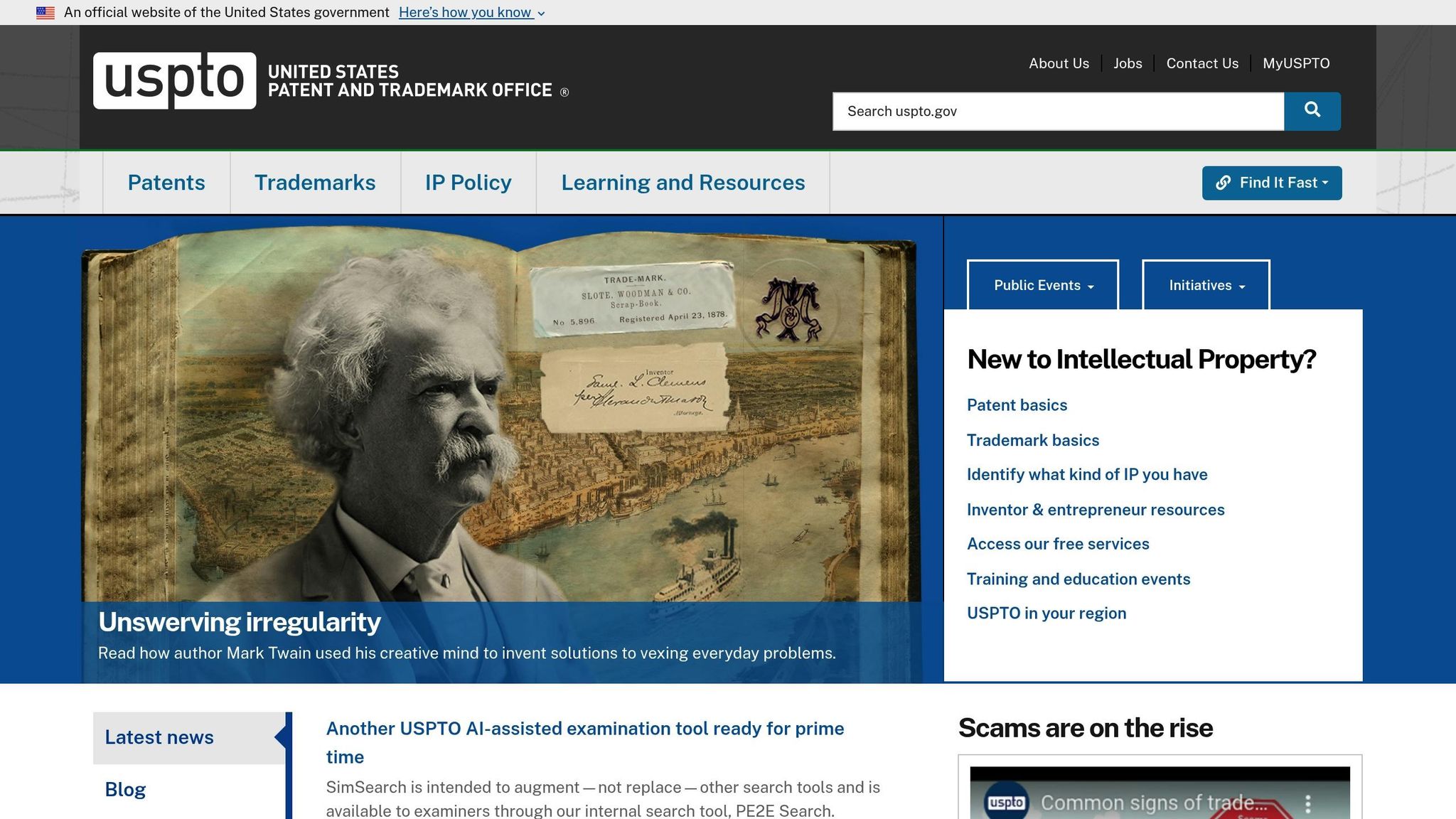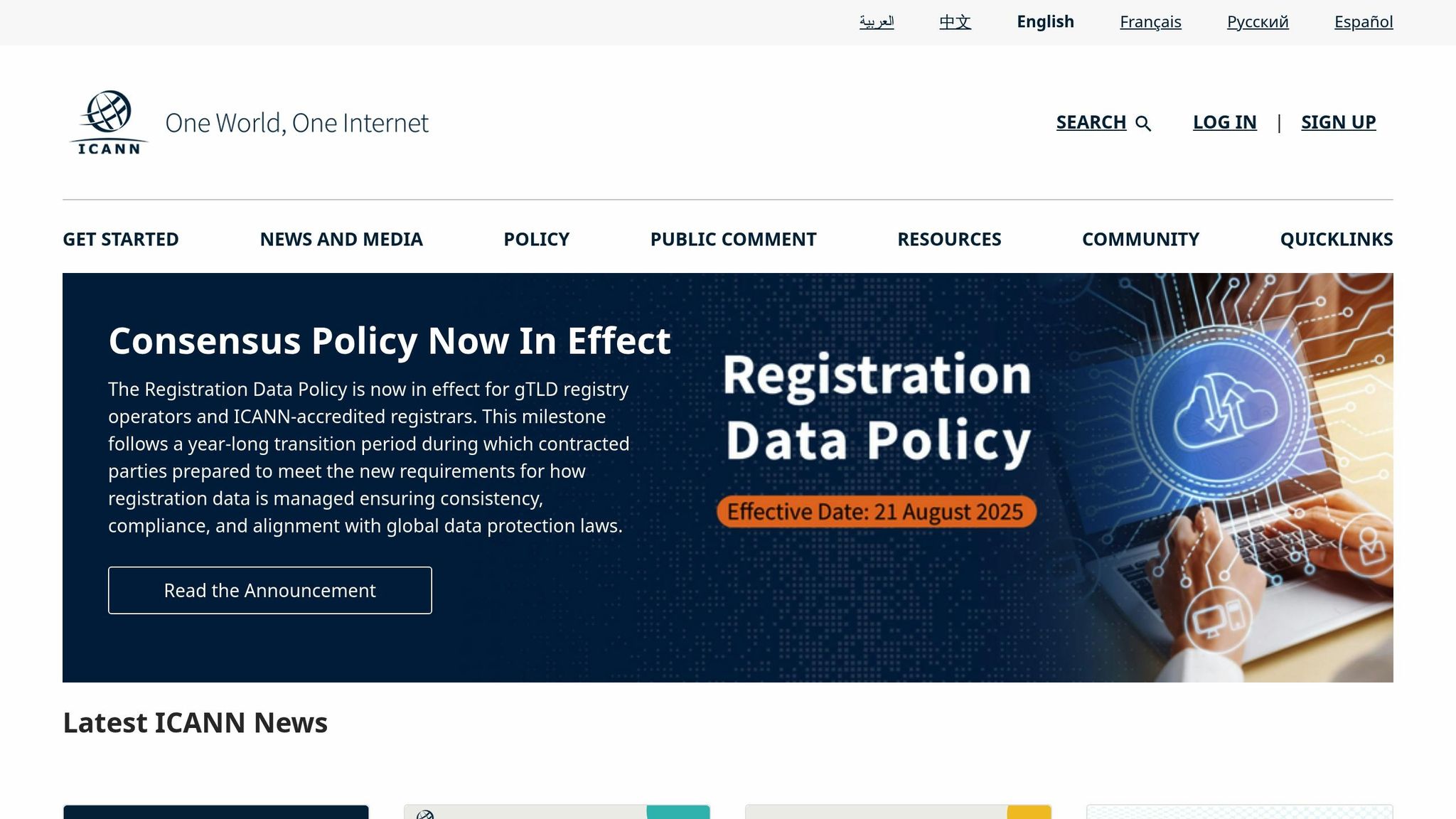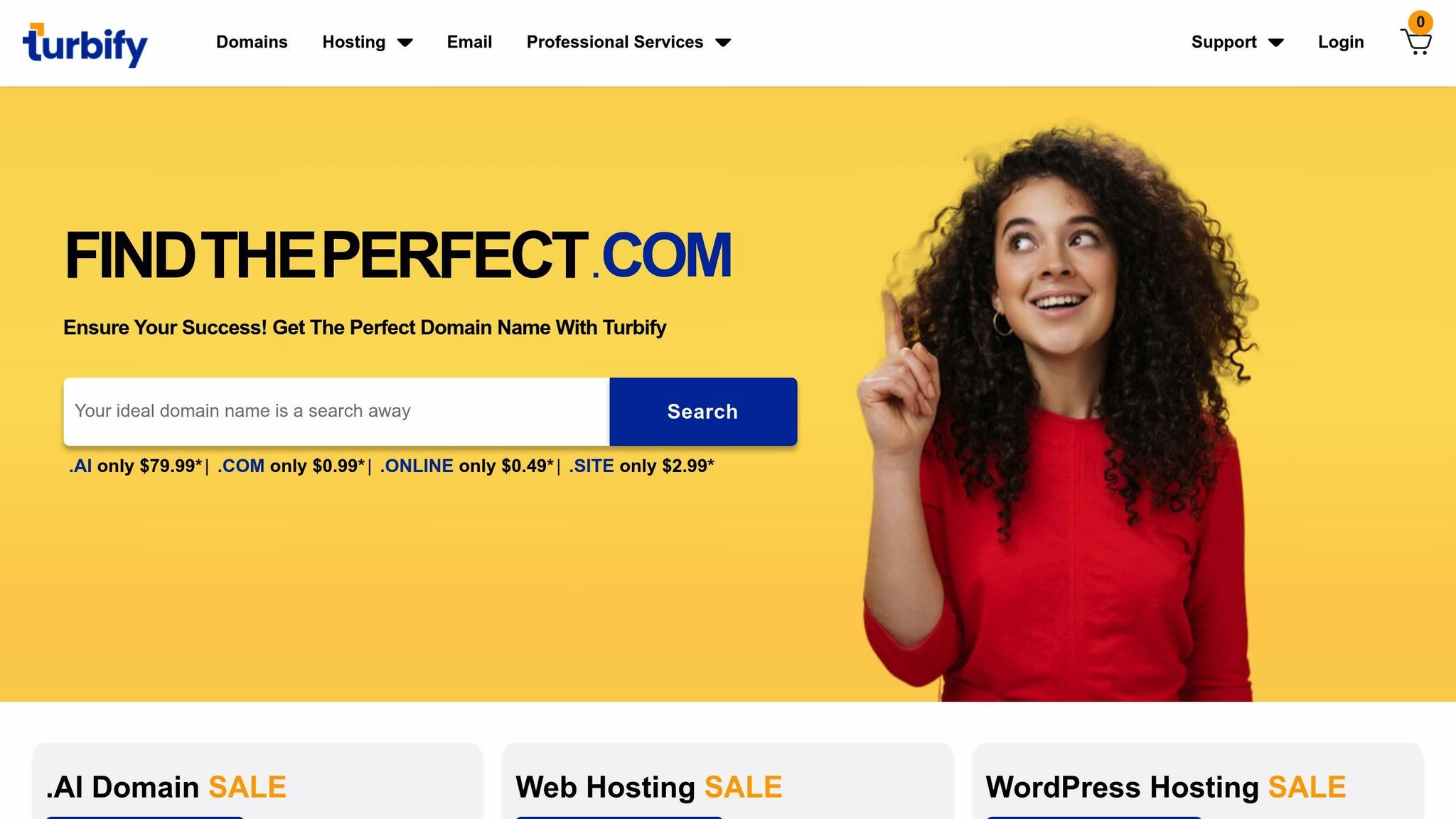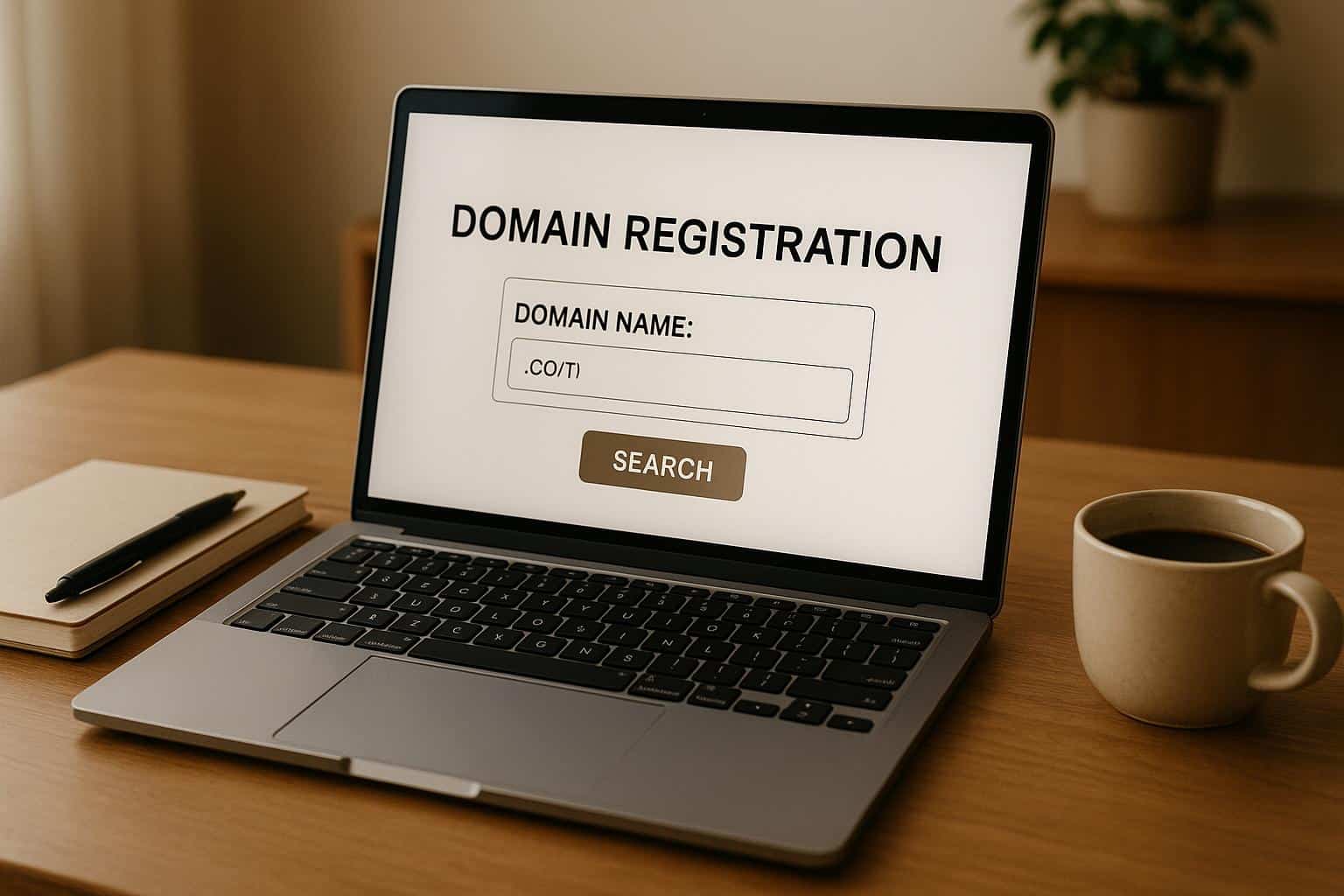Your domain name is your digital storefront – it defines your brand’s first impression and impacts trust, SEO, and credibility. Choosing the right one is crucial. Here’s a quick guide to help you make the best decision:
- Keep it Simple: Choose a short, easy-to-remember name tied to your brand. Avoid numbers, hyphens, and tricky spellings.
- Check Availability: Ensure your desired domain is not already taken and secure variations to avoid confusion.
- Avoid Trademark Issues: Research trademarks to prevent legal problems.
- Pick the Right Extension: While ".com" is the most recognized, consider alternatives like ".tech" or ".store" if they align better with your business.
- Choose a Reliable Registrar: Look for ICANN accreditation, good support, and security features.
- Understand Costs: Be aware of renewal fees and optional services like privacy protection or SSL certificates.
- Provide Accurate Contact Info: Ensure your details are up-to-date to maintain domain ownership.
Following these tips will help you secure a domain that strengthens your brand and builds trust with your audience.
How to buy an EXCELLENT Domain Name – 8 POWERFUL Tips
1. Pick a Simple and Brand-Focused Domain Name
A great domain name is easy to remember, simple to spell, and clearly tied to your brand. Think of it as your online calling card – it should instantly resonate with your audience and be effortless to type. Avoid anything that might confuse visitors or make them second-guess how to find you.
Your domain name should align with your business identity. For example, if you own a bakery called "Sweet Dreams", a domain like sweetdreamsbakery.com immediately tells people what you do and helps them connect your website to your brand. This kind of alignment builds trust and makes your business more recognizable.
Also, think about how your domain name works in everyday use. Whether it’s shared in a conversation, printed on a business card, or included in an email, simplicity ensures it’s easy to recall and share. This brings us to the next point – steering clear of unnecessary complications.
Skip Complex Words, Numbers, and Hyphens
Complicated spellings, numbers, and hyphens create unnecessary hurdles for your audience. If your domain name is tricky to spell or pronounce, people may struggle to find your site. For instance, using "Kwik" instead of "Quick" or "Nite" instead of "Night" might seem clever, but it often leads to confusion and lost visitors.
Numbers are another common stumbling block. Is it "5" or "five"? If people guess wrong, they could end up on the wrong website – or nowhere at all. Hyphens can be equally problematic. For instance, if your domain is best-pizza-chicago.com, someone hearing it might type bestpizzachicago.com instead. Hyphens also disrupt the flow of your brand name and can make your domain appear less professional.
Most successful websites stick with straightforward, hyphen-free names that are easy to say and type. By avoiding these pitfalls, you create a smoother path for your audience to find and remember your website.
Keep It Short and Clear
Short domain names – ideally 15 characters or fewer – reduce errors and are easier to use across different platforms. They look cleaner in email signatures, fit neatly on business cards, and avoid being cut off in search results or social media posts.
Short and clear domains also perform better in search rankings and are more shareable. A concise name leaves more room for your page title and description to shine in search engine results, giving you a better chance to grab attention.
Aim for one or two words that encapsulate your brand or business. While single-word domains are highly desirable, they’re often taken, so combining two short, related words can work just as well. The key is choosing a combination that feels natural and makes sense to your audience. This simplicity reinforces trust and strengthens your brand’s credibility – an essential foundation for building connections online.
2. Check If Your Domain Name Is Available
Before moving forward, make sure the domain name you want is up for grabs. You can use domain search tools to see if your desired name is available across popular extensions like .com, .net, or .org.
If you find a similar domain already in use, think about whether it could mislead or confuse your audience. If so, consider tweaking your name or exploring alternative versions that still align with your brand.
Look for Similar Domain Names
It’s also a good idea to secure variations of your domain. Check for common misspellings or alternative spellings to make sure visitors end up on your site, even if they type the name slightly wrong.
Lastly, double-check that your chosen domain doesn’t infringe on any existing trademarks. Legal issues can be a major headache, so take the time to research this thoroughly.
3. Search for Trademark Issues
Choosing the perfect domain name is exciting, but it can quickly become a legal headache if it infringes on someone else’s trademark rights. Before registering, it’s crucial to ensure your domain name doesn’t conflict with existing trademarks – whether they’re federally registered or common-law trademarks that may not be formally recorded.
Start with a basic trademark search using free tools, but if the situation seems complicated, seeking professional advice is a smart move.
Be on the lookout for obvious conflicts. For instance, a domain name that closely resembles a famous brand could lead to legal trouble due to broader trademark protections. Also, don’t overlook state-level trademarks or common-law rights. While the United States Patent and Trademark Office (USPTO) only checks federal databases, many state trademarks and unregistered common-law marks won’t show up there. That means it’s on you to dig deeper by searching state trademark databases, business registries, and other sources.
A thorough trademark search should cover several areas. This includes federal databases, state registries, business name databases, and internet searches to uncover any existing use of similar names. Keep in mind that trademark rights aren’t limited to exact matches – names that sound similar or operate in related industries can also be problematic.
Search the USPTO Database

The USPTO database is an essential starting point for identifying federal trademark conflicts. This free resource lets you search both registered trademarks and pending applications, giving you insight into what’s already protected at the federal level.
Visit USPTO.gov to access their search tools. To avoid errors during peak times, plan your search when the site is less busy.
Start by searching for your exact domain name, then explore variations and similar spellings. Pay close attention to trademarks that sound alike or might cause confusion with your domain. Trademark protection often extends to related goods and services, not just identical matches.
Don’t forget to check the Trademark Official Gazette (TMOG). This weekly USPTO publication lists trademarks that have received preliminary approval for registration on the Principal Register. Once you’ve reviewed federal records, broaden your search to include state-level and common-law sources.
Use multiple search engines to uncover common-law trademarks. Search for your domain name and similar variations across social media platforms, business directories, and industry websites.
If you’re considering international use, tools like the Madrid Monitor and WIPO’s Global Brand Database can help you identify potential conflicts outside the U.S..
For more complex cases, it’s wise to consult a trademark screening service or work with an experienced U.S.-licensed attorney. They can help interpret your search results and advise on potential risks.
4. Choose the Right Domain Extension
Your domain extension is more than just a technical detail – it’s a key part of your online identity. While .com has long been the go-to choice, there’s now a wide range of extensions available, each suited to different purposes and audiences.
The domain extension you choose can affect how people perceive your site, how easy it is to remember, and even how likely they are to find you online. Since most internet users are familiar with .com, they may instinctively type it in when searching for your site. But if the .com version of your desired domain isn’t available – or doesn’t fit your brand – there are plenty of alternatives that can work well with careful consideration.
When making your choice, think about your audience and industry. For instance, a tech startup might stand out with a .tech extension, while a local café could benefit from a .restaurant domain. The key is aligning your extension with your business goals and the expectations of your target market.
Standard vs. Specialty Domain Extensions
Traditional extensions like .com, .net, and .org have dominated the web for decades, thanks to their widespread recognition and trust. Among these, .com is the most universally recognized and often leads to better brand recall and higher direct traffic. Meanwhile, .net and .org remain popular for certain organizations and businesses.
Specialty extensions, on the other hand, provide more specific branding opportunities. Options like .store, .tech, .design, and .photography make it easy to communicate your business focus at a glance.
| Extension Type | Examples | Best For | Trust Level |
|---|---|---|---|
| Standard | .com, .net, .org | Any business, established brands | Highest |
| Geographic | .us, .nyc, .london | Local businesses, regional focus | High |
| Industry-Specific | .tech, .store, .restaurant | Niche businesses, startups | Medium |
| Creative | .design, .photography, .art | Creative professionals, portfolios | Medium |
For example, a local business in New York might use .nyc to emphasize its regional focus, while a photographer could choose .photography to highlight their niche. However, specialty extensions aren’t as familiar to many users. Someone might assume your site uses .com, which could lead to lost traffic unless you invest in marketing to build awareness.
Cost and Long-Term Strategy
Pricing for domain extensions varies. .com domains are often more affordable, while specialty extensions can cost more and may have higher renewal fees. Be sure to factor in these long-term costs when selecting your domain.
If your budget allows, registering multiple extensions can be a smart move. For instance, securing your .com domain alongside relevant specialty extensions helps protect your brand and reach different audiences. E-commerce businesses might benefit from .store or .shop, while tech companies could explore options like .tech or .io. Still, for broad appeal and easy recognition, .com remains a solid choice.
Your domain extension not only strengthens your brand but also prepares you for the next steps, such as evaluating registration costs and services.
sbb-itb-7459f5e
5. Research Your Domain Registrar
Picking the right domain registrar is just as crucial as choosing the perfect domain name. Your registrar handles the technical side of your domain, manages renewals, and provides key security features. A dependable registrar safeguards your investment and ensures your website remains accessible without interruptions.
Not all registrars are created equal. They differ in pricing, customer support, and available security features. The goal is to find one that offers a balance of affordability, reliability, and essential tools like domain protection and privacy options.
Your registrar choice impacts everything from managing DNS settings to protecting your domain from unauthorized transfers. A poor choice could lead to downtime or even security issues. Start by checking the registrar’s credibility, including any relevant industry certifications.
Check ICANN Accreditation

Make sure the registrar is ICANN-accredited. The Internet Corporation for Assigned Names and Numbers (ICANN) is the global authority for domain name registration. Accredited registrars meet strict standards for operations, security, and financial stability.
ICANN-accredited registrars undergo regular audits and are required to maintain financial reserves and insurance. This ensures they’re reliable and reduces the risk of issues like losing your domain due to mismanagement. With ICANN accreditation, you also benefit from standardized procedures for domain transfers and dispute resolution.
You can verify a registrar’s accreditation status on ICANN’s official website. Look for their accreditation number and check when it was issued. Avoid unaccredited resellers, as they may add unnecessary costs or complicate the process if problems arise.
Beyond accreditation, dig into the registrar’s history. How long have they been in business? Do they have a solid reputation or a track record of outages and complaints? A long-standing ICANN-accredited registrar is more likely to provide stable and reliable service.
Consider Turbify Domain Services

Turbify offers a streamlined approach to domain management with a focus on security and convenience. Their platform includes domain locking, which prevents unauthorized transfers, and user-friendly DNS tools for quick and efficient configuration of your domain settings.
One standout feature is domain privacy protection, which keeps your personal information – such as your name, address, phone number, and email – hidden from public WHOIS databases. Without this protection, your contact details could be exposed, opening the door to spam, unwanted solicitations, or even security risks.
Turbify also integrates domain services with their hosting and website-building tools, making it easier to manage everything in one place. This eliminates the hassle of coordinating between multiple providers when connecting your domain to your website or setting up business email addresses. Their unified dashboard simplifies the process, saving you time and effort.
Another advantage of Turbify is the ability to create personalized email addresses using your domain name. Instead of relying on generic email providers, you can use professional addresses like info@yourdomain.com or sales@yourdomain.com, which strengthens your brand and adds credibility to your communications.
When evaluating registrars, don’t just focus on the initial registration cost. Consider the full range of features included in the package. Turbify’s domain services offer a comprehensive set of tools and security features that many other registrars charge extra for, making it a competitive option when you look at the overall value.
6. Understand Costs and Extra Services
When registering a domain, it’s not just about the initial price tag. Many registrars attract customers with low introductory rates, only to surprise them later with steep renewal fees. To avoid any unpleasant surprises, take a close look at the full cost structure, including renewal pricing, so you can budget accordingly.
Registrars also offer a variety of add-on services to enhance your domain’s functionality and security. These extras might include SSL certificates, email hosting, domain privacy protection, and website builders. Not all of these are essential, so it’s important to distinguish between what you truly need and what might just sound good during a sales pitch. For example, domain privacy protection is vital for safeguarding your personal information, while premium DNS services may not be necessary for a simple business website. Carefully evaluate your needs and avoid paying for features you won’t use.
1-Year vs. Multi-Year Registration
When considering costs, think about how long you want to register your domain. Opting for a multi-year registration can often save you money and reduce the hassle of frequent renewals. Many registrars offer discounts for longer registration terms, and locking in a multi-year deal can protect you from future price hikes. Plus, it minimizes the risk of accidentally letting your domain expire, which could lead to downtime or even losing access to your domain.
That said, there are trade-offs. If you’re uncertain about your long-term plans or might want to switch registrars, a shorter registration term gives you more flexibility. Multi-year registration also means committing more money upfront, which might not be ideal for startups with tight budgets. Weigh the potential savings against your business’s current needs and future plans.
Some registrars sweeten the deal with automatic renewal discounts for multi-year commitments. This can be especially beneficial for premium domain extensions, giving you additional savings over time.
Look at Package Deals
Once you’ve considered registration terms, take a closer look at bundled service options. Many providers offer packages that combine domain registration with services like web hosting, email, and SSL certificates. These bundles can save you money, simplify management, and ensure better integration between services – all accessible from a single dashboard.
For instance, Turbify offers packages that include domain registration, hosting, email, and website tools. This all-in-one approach eliminates the hassle of coordinating multiple vendors and often results in cost savings compared to purchasing each service separately. Plus, having a single point of contact for technical support can make things much easier.
However, bundles aren’t always the best choice. Compare the cost of a package to buying services individually. Some bundles include features you don’t need, which can make them more expensive than picking and choosing services à la carte. Focus on packages that meet your specific requirements instead of going for the ones with the most features.
Also, keep an eye on renewal prices for bundled services. While introductory rates may look attractive, renewal costs can sometimes be significantly higher. A slightly pricier package with consistent renewal pricing might be a smarter investment in the long run.
Finally, think about scalability. As your website grows, you may need more storage, bandwidth, or advanced features. Choosing a package that allows for seamless upgrades within the same provider can save you time and headaches down the road. This is particularly important for ecommerce sites or businesses that anticipate rapid growth.
7. Provide Correct Contact Information
Making sure your contact information is accurate isn’t just a good practice – it’s a legal requirement that safeguards your domain ownership. According to ICANN policies, including the WHOIS Data Reminder Policy, you must provide reliable and up-to-date contact details. Ignoring this obligation could lead to your domain being suspended or even canceled.
This becomes even more crucial under the new ICANN Registration Data Policy, effective August 21, 2025. The policy clarifies that the entity listed in the "Organization" field of your domain contact information is considered the legal owner of the domain. If you’re registering as an individual, leave the "Registrant Organization" field blank. On the other hand, if the domain is for your business, ensure the correct company name is listed to avoid ownership disputes.
Keeping your contact information accurate also ensures you receive critical notifications – like renewal reminders, security alerts, and policy updates – that help prevent issues like domain expiration. While your personal details (including your organization name) are not publicly visible in WHOIS lookup results by default, they still comply with ICANN’s privacy and contact requirements.
Review Your Contact Details
Now that you know how important accurate contact details are, take the time to carefully verify each entry. Pay special attention to your email address, as it’s the primary way registrars will communicate with you about urgent matters.
Make sure your physical address is valid and complete, as ICANN requires a proper postal address. Some registrars might send important legal documents or notifications via mail. Additionally, provide a phone number where you can be reliably reached for verification or in case of security concerns.
If you’re registering a domain for your business, double-check the information entered in the organization field. Under the new ICANN policy, the entity listed there is legally recognized as the domain owner. ICANN also requires registrars to send annual reminders for you to review and update your contact details. When you receive these, act promptly to reflect any changes. Keeping your information accurate today ensures smooth domain management in the future.
Conclusion: Get the Right Domain for Your Website
Picking the right domain name lays the groundwork for your online presence. Following a thoughtful process ensures your domain aligns with your brand and business goals while safeguarding your investment.
A brand-focused domain can enhance recognition and make your business easier to remember. Double-checking availability helps avoid confusion with similar names, and conducting trademark research protects you from legal issues. A quick search through the USPTO database could save you from potential headaches down the road. Pairing this with the right domain extension can enhance your credibility and even improve your search engine visibility.
Opt for an ICANN-accredited registrar to ensure dependable service. Understanding the costs upfront helps you manage your budget effectively and avoid unexpected fees that might strain your finances.
Lastly, keeping your contact details accurate is essential for maintaining domain ownership. Every step in this process strengthens your digital foundation, setting you up for a successful registration.
Once you’ve checked off every step, consider registering your domain with Turbify. They offer features like domain locking, flexible DNS management, and reliable customer support to help you secure a domain that supports your business growth and builds trust with your audience.
FAQs
How can I make sure my domain name doesn’t violate any trademarks?
Before settling on a domain name, make sure to do your homework. Start by checking the USPTO database and other trademark registries to ensure your chosen name isn’t already trademarked or too close to existing ones. A distinct and original name can go a long way in minimizing the risk of legal headaches.
Also, take some time to understand the Uniform Domain Name Dispute Resolution Policy (UDRP). This policy explains how disputes over domain names are resolved. By taking these precautions early on, you can steer clear of legal issues and set a strong foundation for your brand.
What should I consider when deciding between a standard and specialty domain extension for my business?
When choosing between a standard and specialty domain extension, consider how well the extension reflects your brand and appeals to your audience. Standard extensions like .com are highly recognized, trusted, and easy for people to remember. They’re often a reliable option if you’re aiming to establish credibility.
On the other hand, specialty extensions such as .tech or .ai can emphasize your industry or niche, helping your domain stand out in a crowded space. Keep in mind, though, these options are usually pricier – ranging from $50 to $100 annually – and might not feel as familiar to everyone.
In the end, go with an extension that aligns with your brand identity, connects with your audience, and fits comfortably within your budget.
Why should I choose an ICANN-accredited registrar, and how can I confirm their accreditation?
Choosing an ICANN-accredited registrar is a smart move because it guarantees the registrar operates under stringent guidelines designed to prioritize security, reliability, and consumer protection. This means you’re less likely to face issues like domain theft, fraud, or subpar service, making domain management a lot less stressful.
To verify if a registrar is accredited, head to ICANN’s official website. They maintain an updated list of approved registrars, so you can easily check. You can also confirm that the registrar’s accreditation agreement is current, as ICANN routinely reviews and renews these agreements to ensure compliance.




